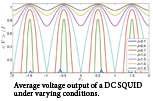Grasp of SQUIDs dynamics facilitates eavesdropping

Theoretical physicists are currently exploring the dynamics of a very unusual kind of device called a SQUID. This Superconducting Quantum Interference Device is a highly sensitive magnetometer used to measure extremely subtle magnetic fields. It is made of two thin regions of insulating material that separate two superconductors – referred to as Josephson junctions – placed in parallel into a ring of superconducting material.
In a study published in European Physical Journal B, US scientists have focused on finding an analytical approximation to the theoretical equations that govern the dynamics of an array of SQUIDs. This work was performed by Susan Berggren from the US Navy research lab, SPAWAR Systems Center Pacific, in San Diego, CA, USA and Antonio Palacios of San Diego State University. Its applications are mainly in the military sector, including SQUID array-based low-noise amplifiers and antennas.
Simulating the dynamics of large arrays of SQUIDs costs a great deal of time, computing power and energy. Instead the authors employed an analytical approximation technique known as a perturbation analysis to reduce the computation time to practically zero. This involves selecting small system parameters as perturbation parameters, and applying them to the array of SQUIDs to create a solution, which helps represent the dynamics of such arrays.
In this study, the authors tested two different approximations. They compared the complete analytical solution for the two approaches using the model equation forms traditionally used for the numerical simulations, then plotted both solutions to determine the effects of the approximation errors on the average voltage versus magnetic field response. In a last step, they applied the most precise approximation to a series coupled array of SQUIDs. The resulting model of the average voltage versus magnetic field response helped them evaluate the sensitivity of such magnetometers, while also shaping future applications.
More information: S. Berggren and A. Palacios (2014), Analytical Approximations to the Dynamics of an Array of Coupled DC SQUIDs, European Physical Journal B, DOI: 10.1140/epjb/e2014-50065-9
Journal information: European Physical Journal B
Provided by Springer



















